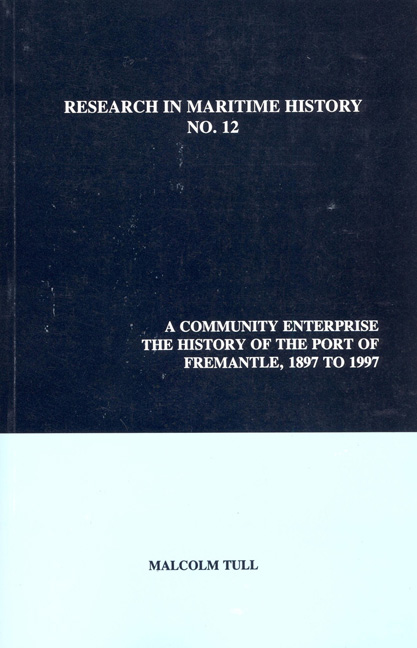Book contents
- Frontmatter
- Table of Contents
- List of Tables
- List of Figures
- List of Photos
- Acknowledgements
- Abbreviations
- Conversions
- Introduction
- Chapter 1 The Birth of A Modern Port
- Chapter 2 The Establishment of The Fremantle Harbour Trust
- Chapter 3 The Development Of Trade At The Port of Fremantle
- Chapter 4 The Shipping of Fremantle
- Chapter 5 A Century of Port Development, 1897 To 1997
- Chapter 6 Cargo-Handling Technology, Working Conditions And Industrial Relations on The Fremantle Waterfront
- Chapter 7 From Port Authority To Strategic Manager: The Transformation of The FPA
- Appendix A Trade and Shipping Statistics
- Appendix B Financial Statistics
- Appendix C Labour Statistics
- Appendix D
- Bibliography
- Index
Chapter 6 - Cargo-Handling Technology, Working Conditions And Industrial Relations on The Fremantle Waterfront
- Frontmatter
- Table of Contents
- List of Tables
- List of Figures
- List of Photos
- Acknowledgements
- Abbreviations
- Conversions
- Introduction
- Chapter 1 The Birth of A Modern Port
- Chapter 2 The Establishment of The Fremantle Harbour Trust
- Chapter 3 The Development Of Trade At The Port of Fremantle
- Chapter 4 The Shipping of Fremantle
- Chapter 5 A Century of Port Development, 1897 To 1997
- Chapter 6 Cargo-Handling Technology, Working Conditions And Industrial Relations on The Fremantle Waterfront
- Chapter 7 From Port Authority To Strategic Manager: The Transformation of The FPA
- Appendix A Trade and Shipping Statistics
- Appendix B Financial Statistics
- Appendix C Labour Statistics
- Appendix D
- Bibliography
- Index
Summary
In previous chapters we have seen that the structural transformation of the waterfront industry from a labour intensive to a capital intensive one did not begin until the 1940s when forklifts and pallets were introduced by the American armed forces. However, the most dramatic changes occurred in the late 1960s with the introduction of containerisation. This technology placed increased pressures on the ports to improve efficiency and labour productivity and had far-reaching implications for the workforce. The objective of this chapter is to examine the evolution of cargo-handling practices, working conditions and employment on the waterfront at Fremantle.
Cargo-Handling Technology and Working Conditions on the Waterfront
Stevedoring, that is, the physical handling of ships’ cargo, is unique to the ports industry. By the late 1930s most ports in developed countries handled homogeneous cargoes such as grain, coal, and oil in bulk using mechanical devices such as conveyors, elevators and pipelines. But the handling of general cargo remained primarily a manual task, requiring “a mighty arm, a hard muscle, and a large strong back.” In the case of imports, for example, cargoes were usually loaded into slings or onto wooden platforms and discharged using ships’ gear or wharf cranes. The wharf labourers, or lumpers as they were known at Fremantle, would transfer the contents of the sling or platform to the wharf shed. Usually, the only piece of mechanical equipment used was a two wheeled sack truck, equipped with a blade or other load support which was prised beneath the cargo, but at some ports, including Fremantle, four-wheeled platform trucks and trolleys operated by manpower were also used.
By means of the “bull” system stevedores achieved high handling rates from the men. Foremen selected men for work at the daily pick-up. Strong men known as “bulls” were used to set the pace of work and, with the ever present fear of unemployment, the men could be relied on to work feverishly. Competition for work was so great, especially during the 1930s depression that it was difficult for even regular followers of the industry to earn a living wage. Inexperienced casuals, who were employed only after all the experienced workers had been employed, became known as “seagulls,” as they fought for work like birds fighting for titbits of food.
- Type
- Chapter
- Information
- A Community EnterpriseThe History of the Port of Fremantle, 1897 to 1997, pp. 201 - 242Publisher: Liverpool University PressPrint publication year: 1997



